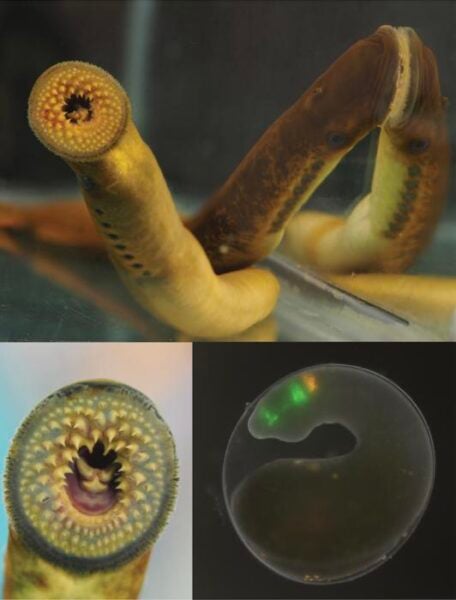The sea lamprey, a 500-million-year-old animal with a sharp-toothed suction cup for a mouth, is the thing of nightmares. A new study from the Stowers Institute for Medical Research discovered that the hindbrain—the part of the brain controlling vital functions like blood pressure and heart rate—of both sea lampreys and humans is built using an extraordinarily similar molecular and genetic toolkit.
Research from the lab of Investigator Robb Krumlauf, Ph.D., published on February 20, 2024 in Nature Communications offers a glimpse into how the brains of ancient animals evolved. The team unexpectedly uncovered that a crucial molecular cue is very broadly required during vertebrate hindbrain development.
“This study on the hindbrain is essentially a window into the distant past and serves as a model for understanding the evolution of complexity,” said co-author Hugo Parker, Ph.D.
Like other vertebrate animals, sea lampreys have a backbone and skeleton, but they are noticeably missing a feature of their heads—a jaw. Because most vertebrates, including humans, have jaws, this striking difference in sea lampreys makes them valuable models for understanding the evolution of vertebrate traits.
“There was a split at the origin of vertebrates between jawless and jawed around 500 million years ago,” said Alice Bedois, Ph.D., a former predoctoral researcher in the Krumlauf Lab and lead author on the study. “We wanted to understand how the vertebrate brain evolved and if there was something unique to jawed vertebrates that was lacking in their jawless relatives.”
Previous work from the Krumlauf Lab and the lab of Marianne Bronner, Ph.D., at the California Institute of Technology had identified that the genes structuring and subdividing the sea lamprey hindbrain are identical to those in jawed vertebrates including humans.
However, these genes are part of an interconnected network or circuit that needs to be initiated and directed to build the hindbrain correctly. The new study identified a common molecular cue, while known to direct head-to-tail patterning in a wide variety of animals, as part of the gene circuitry guiding hindbrain patterning in sea lampreys.
“We found that not only are the same genes but also the same cue is involved in sea lamprey hindbrain development, suggesting this process is ancestral to all vertebrates,” said Bedois.
This cue is called retinoic acid, commonly known as vitamin A. While the researchers knew that retinoic acid cues the gene circuitry to build the hindbrain in complex species, it was not thought to be involved for more primitive animals like sea lampreys. Surprisingly, they found that the sea lamprey core hindbrain circuit is also initiated by retinoic acid, providing evidence that these sea monsters and humans are much more closely related than anticipated.
“People thought that because sea lampreys lack a jaw, their hindbrain was not formed like other vertebrates,” said Krumlauf. “We have shown that this basic part of the brain is built in exactly the same way as mice and even humans.”
There are well known signaling molecules that inform the fate of cells during development. Now, the researchers have found that retinoic acid is another major player that cues vital steps in development like formation of the brain stem. In addition, if hindbrain formation is a conserved feature for all vertebrates, other mechanisms must be responsible to explain their incredible diversity.
“We all derived from a common ancestor,” said Bedois. “Sea lampreys have provided an additional clue. Now we need to look even further back in evolutionary time to discover when the gene circuitry governing hindbrain formation first evolved.”
Additional author: Marianne Bronner, Ph.D.
This work was funded by the National Institute of Neurological Disorders and Stroke (award: R35NS111564) of the National Institutes of Health (NIH) and by institutional support from the Stowers Institute for Medical Research. The content is solely the responsibility of the authors and does not necessarily represent the official views of the NIH.
About the Stowers Institute for Medical Research
Founded in 1994 through the generosity of Jim Stowers, founder of American Century Investments, and his wife, Virginia, the Stowers Institute for Medical Research is a non-profit, biomedical research organization with a focus on foundational research. Its mission is to expand our understanding of the secrets of life and improve life’s quality through innovative approaches to the causes, treatment, and prevention of diseases.
The Institute consists of 20 independent research programs. Of the approximately 500 members, over 370 are scientific staff that include principal investigators, technology center directors, postdoctoral scientists, graduate students, and technical support staff. Learn more about the Institute at www.stowers.org and about its graduate program at www.stowers.org/gradschool.
Media Contact:
Joe Chiodo, Head of Media Relations
724.462.8529
[email protected]


